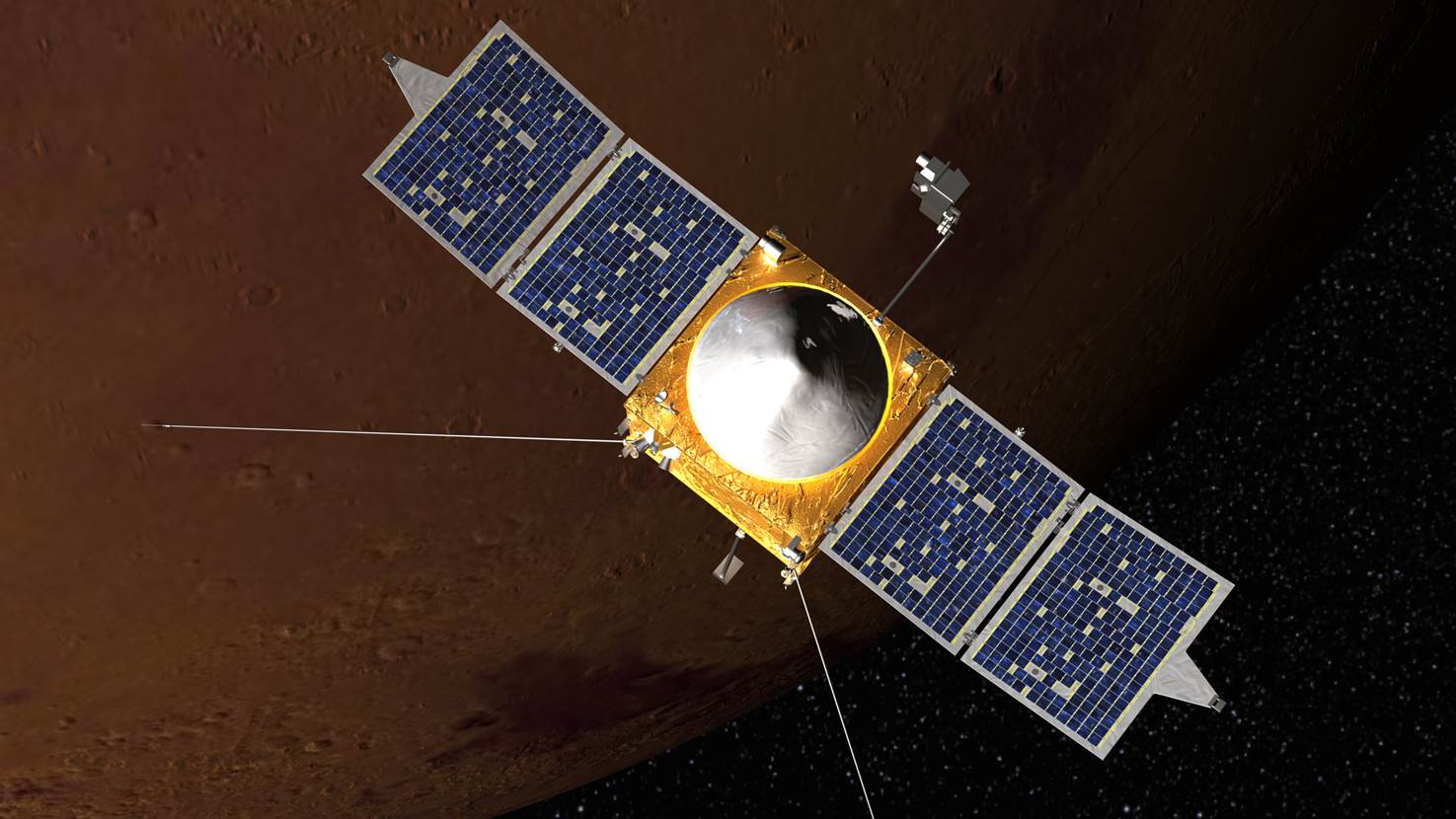Sent from my iPad
Begin forwarded message:
From: Kent Castle <kent.d.castle@hotmail.com>
Date: August 6, 2013 4:18:38 PM GMT-06:00
To: Choban Peter <peter.s.choban@aero.org>, Baird Darren <darren.t.baird@nasa.gov>, Bentz Jerry <bentz@sbcglobal.net>, Hart Harry <hwhart@embarqmail.com>, Martin Bobby <bobbygmartin1938@gmail.com>, Patterson James <w8ljz@aol.com>, Reason Marilou <loganlou55@yahoo.com>
Subject: FW: MAVEN arrives at KSC
From:
Subject: FW: MAVEN arrives at KSC
Date: Mon, 5 Aug 2013 21:15:04 -0500
Aug. 3, 2013
MAVEN makes its last stop before Mars
Orbiter arrives at KSC; November launch planned
MAVEN: Mars atmospheric loss: NASA's MAVEN spacecraft will give us a clearer idea of how Mars lost its atmosphere, and scientists think that several processes have had an impact. NASA video. Originally posted Sept. 2012.
Written by
James Dean
FLORIDA TODAY
Zoom
NASA's MAVEN underwent acoustics testing in February at Lockheed Martin Space Systems' Reverberant Acoustic Laboratory. MAVEN is the first spacecraft devoted to understanding the Martian upper atmosphere. / Lockheed Martin Corp.
Contact Dean at 321-242-3668 orA NASA spacecraft has reached its last stop before embarking on a 10-month journey to Mars, arriving Friday at Kennedy Space Center to prepare for a planned November blastoff.
An Air Force C-17 cargo plane delivered the MAVEN orbiter from Colorado to the former shuttle runway around 8 p.m.
MAVEN is short for "Mars Atmosphere and Volatile Evolution."
The $671 million mission, carrying three suites of instruments, will spend at least a year studying the Red Planet's upper atmosphere and climate history.
Scientists hope to learn more about why most of Mars' once thicker, warmer atmosphere was lost, changing a more habitable climate to its current cold, dry state.
After its delivery here, the Lockheed Martin Corp.-built orbiter was headed to KSC's Payloads Hazardous Servicing Facility for pre-launch testing.
The spacecraft is expected to move to a Cape Canaveral launch pad in early November to be hoisted atop a United Launch Alliance Atlas V rocket.
The launch must hit a 20-day window between Nov. 18 and Dec. 7, or else wait two years for the proper planetary alignment to return.
NASA says the mission is on track to launch Nov. 18 and begin orbiting Mars in September 2014.
NASA on Tuesday will celebrate the anniversary of its Curiosity rover touching down on the Martian surface.
After MAVEN, the space agency plans to launch the InSight stationary lander to Mars in 2016, and is studying the possible launch of another rover in 2020.
jdean@floridatoday.com.
Copyright © 2013 www.floridatoday.com. All rights reserved.
===============================================================
AmericaSpace
For a nation that exploresAugust 4th, 2013
Mars Probe Arrives at Kennedy Space Center
By David Darling
NASA's MAVEN spacecraft has arrived at Kennedy Space Center in Florida in preparation for a November launch to the Red Planet. Image Credit: NASA / Goddard Space Flight CenterNASA's next spacecraft bound for Mars—the $450 million MAVEN (Mars Atmosphere and Volatile EvolutioN) mission—completed its final Earth-bound journey yesterday, Friday, Aug. 2 at NASA's Kennedy Space Center in Florida. This is in preparation for the spacecraft's interplanetary trek to the Red Planet, currently slated to take place this November atop a United Launch Alliance Atlas V rocket.
Secure inside a 6-ton, 4.3-meter wide and tall container, MAVEN first took the short road trip from its place of manufacture, Lockheed-Martin's satellite plant located in Denver, to nearby Buckley Air Force Base on a flatbed trailer. The specially built container ensured that the spacecraft was kept at a constant temperature of 70 degrees Fahrenheit and a humidity of less 30 percent, while continuous purging with nitrogen gas ensured a clean internal environment. At Buckley, the multi-instrumented orbiter and its bulky cocoon was loaded into a Boeing C-17 transport plane and flown the approximately 1,600 miles to the Shuttle Landing Facility at Kennedy Space Center.
MAVEN is the first probe purpose-built to investigate the upper Martian atmosphere, ionosphere, and interactions with the Sun and solar wind. Researchers will use its suite of eight sensors, including spectrometers, a magnetometer, and particle detectors, in an effort to understand what happened to transform the Red Planet from the warm, wet place it used to be several billion years ago to the cold, arid world it is today.
"The data could be used to build models showing how Mars has lost the majority of its atmosphere, a phenomenon that continues to be one of the planet's greatest mysteries," said Paul Mahaffy, an investigator working on MAVEN.
Having arrived at KSC, MAVEN will now begin processing in readiness for launch during a 20-day window that opens on November 18, atop a United Launch Alliance Atlas V-401. Following a 10-month voyage to the Red Planet, the probe will enter orbit in September 2014. A five-week commissioning period will then ensue, during which the spacecraft will adjust its orbit in readiness for the start of science operations and its one-year primary mission.
"It is one step in getting to a really big question, which is, 'Are we alone in the universe?'" Mahaffy said. "MAVEN is one step in that program for understanding life on early Mars, and we'll try to do everything we can to understand it."
Copyright © 2013 AmericaSpace - All Rights Reserved
===============================================================



No comments:
Post a Comment